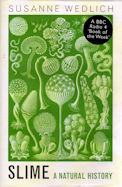In this groundbreaking and fascinating book, Susanne Wedlich leads us on a scientific journey through the 3-billion year history of slime, from the part it played in the evolution of life on this planet to the way it might feature in the post-human future. She also explores the cultural and emotional significance of slime, from its starring role in the horror genre to its subtle influence on Art Nouveau. Slime is what connects Patricia Highsmith’s fondness for snails, John Steinbeck’s aversion to hagfish and Emperor Hirohito's passion for jellyfish, as well as the curious mating practices of underwater gastropods and the miraculous functioning of the human gut. Written with authority, wit and eloquence, Slime brings this most nebulous and neglected of substances to life.
Slime is ubiquitous in living systems: as glue holding bacterial mats together, as lubricant allowing us to swallow our food, as both glue and lubricant excreted by slugs and snails to travel on, and much much more.
In this fascinating book, Wedlich explores all things slime (or mucus, or even biological aqueous hydrogel to sound more formal, if less attention-grabbing). She covers our human reaction to slime (the ick factor), and its role in art and culture; the physics of slime and how it can be both glue and lubricant; slime in organisms, particularly bacteria; the role of slime in the origin and evolution of life; and the place of slime in our ecosystems. This is all utterly fascinating, with new revelations on nearly every page. I had thought I knew at least something about the various major processes in biology: after reading this, I feel as if I have discovered a whole new kingdom.
I learned a lot, not just about organisms and evolution, but unexpected aspects like the role of slime in deserts and sea surfaces, and how climate change threatens the delicate balance of this almost unrecognised but crucial component of our biome. Highly recommended.
[Disclaimer: I was given my copy of this, in preparation for my hosting a discussion with the author during the York Festival of Ideas 2022.]
